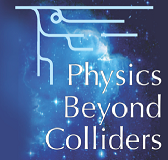Speaker
Description
In this talk, we review a number of recent ideas$^*$ put forward in favour of a fixed-target programme at the LHC - AFTER@LHC- dedicated to heavy-ion, hadron, spin and astroparticle physics. By extracting the beam with a bent crystal or by using an internal gas target, the multi-TeV LHC beams allow one to perform the most energetic fixed-target experiments ever with which one can access the essentially uncharted backward kinematics with detectors similar to LHCb or ALICE.
In particular we argue that this allows one to study $pp$, $pd$ and $pA$ collisions at $\sqrt{s_{NN}}\simeq $115 GeV and Pb$p$ and Pb$A$ collisions at $\sqrt{s_{NN}}\simeq $72 GeV with extremely high precision with modern detection techniques. Such studies, including
- single transverse-spin asymmetries for hard and rare processes,
- suppression of heavy-flavours and quarkonia as well as azimuthal asymmetries down to the target rapidity in heavy-ion collisions,
- cold-nuclear matter effects,
- the physics involved in ultra-peripheral hadron and ion collisions,
- far backward gluon and heavy-quark sensitive processes,
- vector-boson production near threshold ...,
would greatly complement collider experiments, in particular those of the Electron-Ion Collider project or RHIC (with luminosities larger by 1 to 3 orders of magnitude).
Such a mode indeed allows for a broad physics programme, covering the large-$x$ QCD frontier for particle and astroparticle physics, as well as spin and heavy-ion physics with respectively a polarised target and the LHC lead beam.
$^*$: for a complete list of references see
http://after.in2p3.fr/after/index.php/Recent_published_ideas_in_favour_of_AFTER@LHC
